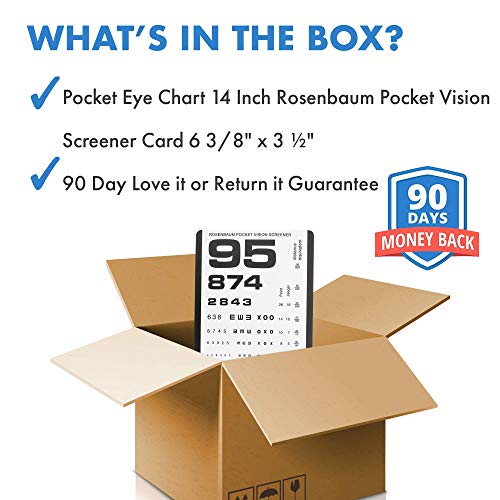All Categories




Pocket Eye Chart 14 Inch Rosenbaum Pocket Vision Screener Card 6 3/8" x 3 ½"
Share Tweet
of brand new stock?
or
Need this item ASAP?
Check if this is available on Amazon
or available in other sites
Send us the link so we can buy for you








Pocket Eye Chart 14 Inch Rosenbaum Pocket Vision Features
-
DOUBLE-SIDED POCKET VISION SCREENER THAT HAS 20/800 TO 20/20 ACUITY MEASUREMENTS - Use at 14” Provides 20/800 distance The Rosenbaum card is the most widely used handheld card for measuring near visual acuity
-
PRECISE, CLEAR, LEGIBLE - Plastic/Matte Finish with price clear and legible to best ensure the accuracy of giving a visual acuity test is used to determine the smallest letters you can read on a standardized chart
-
METRIC & ENGLISH SCALE - The back of the card features a millimeter scale and an inch scale
-
WASHABLE FLEXIBLE PLASTIC. MEASURES 3 1/2" X 6 3/8" - Durable, laminated plastic fits easily in a pocket for quick, convenient visual acuity screening
-
A HANDY PORTABLE CARD WITH MANY USES - Also lists Jaeger and point scales of print. Has a pupil gauge from 2 to 9 mm and has inch and metric rulers
About Pocket Eye Chart 14 Inch Rosenbaum Pocket Vision
Pivit Pocket Vision Screener Instructions Visual acuity (Va) can be assessed by using the Pocket Vision Screener (not to be confused with the larger Snellen eye chart). The Pocket Vision Screener gives a distance equivalent Va even though the card is held 14" from the patient. Va testing is done in the following manner: Have the patient wear their corrective lenses (if any), make sure the card is evenly illuminated, and instruct the patient to hold the test card 14" away from their eyes. Corrective lenses are worn in order to determine the "best-corrected” Va. Ask the patient to cover their left eye (the right eye is always examined first). Ask the patient to say each letter or read each word on the line of smallest characters that are legible on the card. Record the Va for the right eye according to the accepted notation method. Repeat the process for the left eye and then with both eyes viewing the test card and record the Va. Patient's who cannot see the letters or numbers on the card should have their vision recorded as count fingers (e.g., CF at 5ft), hand motion (e.g., HM at 2 ft), light perception (LP), or no light perception (NLP).



















